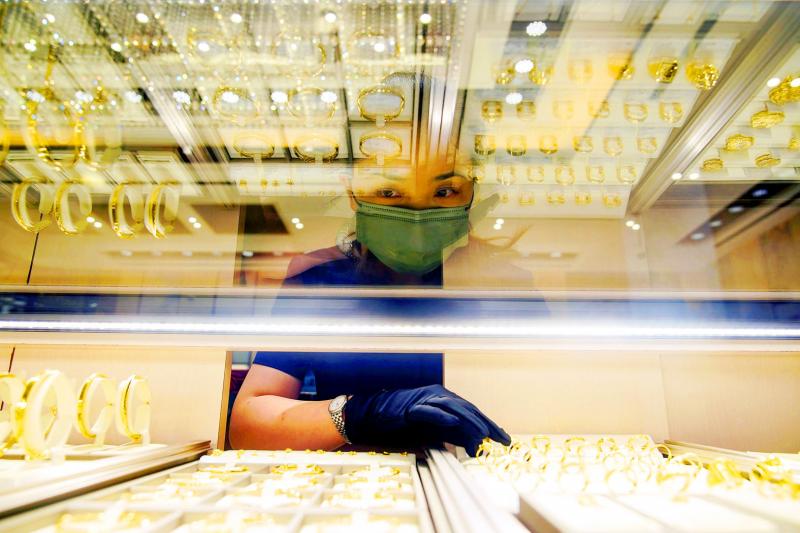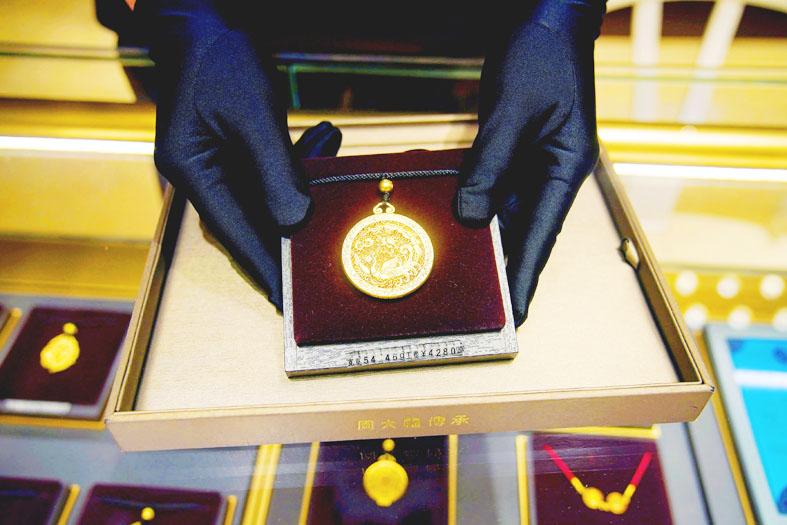For many affluent young Chinese consumers, modern simplicity is out and tradition is back in when it comes to jewelry.
Sales of gold bracelets, pendants, earrings and necklaces that draw on dragons, phoenixes, peonies and other traditional Chinese patterns and symbols are flying among consumers, especially those in their 20s and 30s, helping drive a rebound in gold demand in the country after a COVID-19-pandemic-induced slump.
An e-commerce boom and national pride are fueling the rise in demand for what is known as heritage gold jewelry, which requires intricate craftsmanship and can command premiums of 20 percent or more over conventional gold jewelry, industry executives say.

Photo: Reuters
The popularity of these pieces began to take off in the middle of last year and helped gold jewelry demand in China — the world’s top consumer of the metal — more than double in the first half of this year from a year earlier to pre-pandemic levels, the World Gold Council said.
A strengthening economy and improving consumer spending are helping sales. Young consumers’ interest in the classic designs and often chunky gold jewelry with a matte finish marks a turnaround in their appetite for the precious metal, previously eschewed as an ostentatious sign of wealth and status symbol for older generations.
It also provides a boost for gold at a time when demand from India, the world’s second-largest consumer, has been hit as the pandemic delayed weddings, where gold is traditionally included in the dowry.

Photo: Reuters
Major Chinese jewelry retailers such as Hong Kong-listed Chow Tai Fook Jewellery Group Ltd (周大福珠寶) and Luk Fook Holdings International Ltd (六福珠寶集團) said their heritage gold collections are doing well especially among young consumers.
Chow Tai Fook, China’s largest jeweler by market value, said its heritage gold collection accounted for 40 percent of the total value of its retail sales of gold products in mainland China in its fiscal year ended March — up from 29 percent the previous year, faster growth than for other jewelry.
Part of heritage gold jewelry’s appeal, especially among young consumers, reflects a desire to be patriotic amid a backlash against Western apparel brands in China that expressed concern over allegations of rights abuses in the Chinese region of Xinjiang. Beijing has denied the allegations.
“The younger generation grew up when China’s economy was stronger. They have more confidence in Chinese development and may have less admiration for Western culture,” World Gold Council China managing director Roland Wang (王立新) said.
“They want to have more traditional Chinese culture in their daily life, which can be represented through what they wear or how they decorate their home... Heritage gold can deliver this,” he added.
Gao, a 29-year-old sales executive from eastern Jiangsu Province, who only wanted to be identified by a single name, said that she has spent 30,000 yuan (US$4,635) this year on a bracelet and hairpin, featuring filigree patterns, for everyday use. She plans to pass them on to her two-year-old daughter one day.
“I really like Chinese culture and prefer products with Chinese history. I often wear [traditional] Han-style clothing, which is why I choose heritage gold, to match my overall look,” Gao said.
Jewelers say the products are increasingly popular with young consumers in Beijing, Shanghai and other big cities, and a boom in e-commerce, giving consumers access to much greater choice of jewelry products, is reinforcing the trend.
“The pandemic indeed made me spend more on gold jewelry... It sparked a lot of livestreaming sales,” Gao said.
In anticipation of longer-term demand, gold jewelry manufacturers are stepping up investment in heritage gold.
A manager at a Shenzhen-based manufacturer, who declined to be identified as he was unauthorized to speak to the media, said his firm is mainly promoting heritage gold this year after receiving large orders from major brands and customers.
“Heritage gold sales were amazing this Lunar New Year holiday, surpassing that of conventional gold jewelry,” he said.
“After seeing this trend, our company expanded research and development on design and technology to create more new designs of heritage gold. Other gold jewelry manufacturers in Shenzhen are doing the same,” he added.
The China Gold Association said that heritage gold jewelry has become the main driving force in the industry’s recovery from the effects of the pandemic, and fast growth looks set to continue.
According to industry and market research consultancy Beijing Zhiyan Kexin Consulting Co (北京智研科信諮詢), the market for heritage gold in China increased 10-fold from 2017 to 2019, and is seen reaching nearly 100 billion yuan by 2024. Its share of China’s gold jewelry market is forecast to jump from less than 2 percent in 2017 to nearly one-quarter by 2024.
“Gold jewelry enterprises are rapidly recognizing the importance of cultural value and are digging deep into it,” the consultancy said in a report on heritage gold in January.

WEAKER ACTIVITY: The sharpest deterioration was seen in the electronics and optical components sector, with the production index falling 13.2 points to 44.5 Taiwan’s manufacturing sector last month contracted for a second consecutive month, with the purchasing managers’ index (PMI) slipping to 48, reflecting ongoing caution over trade uncertainties, the Chung-Hua Institution for Economic Research (CIER, 中華經濟研究院) said yesterday. The decline reflects growing caution among companies amid uncertainty surrounding US tariffs, semiconductor duties and automotive import levies, and it is also likely linked to fading front-loading activity, CIER president Lien Hsien-ming (連賢明) said. “Some clients have started shifting orders to Southeast Asian countries where tariff regimes are already clear,” Lien told a news conference. Firms across the supply chain are also lowering stock levels to mitigate

IN THE AIR: While most companies said they were committed to North American operations, some added that production and costs would depend on the outcome of a US trade probe Leading local contract electronics makers Wistron Corp (緯創), Quanta Computer Inc (廣達), Inventec Corp (英業達) and Compal Electronics Inc (仁寶) are to maintain their North American expansion plans, despite Washington’s 20 percent tariff on Taiwanese goods. Wistron said it has long maintained a presence in the US, while distributing production across Taiwan, North America, Southeast Asia and Europe. The company is in talks with customers to align capacity with their site preferences, a company official told the Taipei Times by telephone on Friday. The company is still in talks with clients over who would bear the tariff costs, with the outcome pending further

Six Taiwanese companies, including contract chipmaker Taiwan Semiconductor Manufacturing Co (TSMC, 台積電), made the 2025 Fortune Global 500 list of the world’s largest firms by revenue. In a report published by New York-based Fortune magazine on Tuesday, Hon Hai Precision Industry Co (鴻海精密), also known as Foxconn Technology Group (富士康科技集團), ranked highest among Taiwanese firms, placing 28th with revenue of US$213.69 billion. Up 60 spots from last year, TSMC rose to No. 126 with US$90.16 billion in revenue, followed by Quanta Computer Inc (廣達) at 348th, Pegatron Corp (和碩) at 461st, CPC Corp, Taiwan (台灣中油) at 494th and Wistron Corp (緯創) at

NEGOTIATIONS: Semiconductors play an outsized role in Taiwan’s industrial and economic development and are a major driver of the Taiwan-US trade imbalance With US President Donald Trump threatening to impose tariffs on semiconductors, Taiwan is expected to face a significant challenge, as information and communications technology (ICT) products account for more than 70 percent of its exports to the US, Chung-Hua Institution for Economic Research (CIER, 中華經濟研究院) president Lien Hsien-ming (連賢明) said on Friday. Compared with other countries, semiconductors play a disproportionately large role in Taiwan’s industrial and economic development, Lien said. As the sixth-largest contributor to the US trade deficit, Taiwan recorded a US$73.9 billion trade surplus with the US last year — up from US$47.8 billion in 2023 — driven by strong